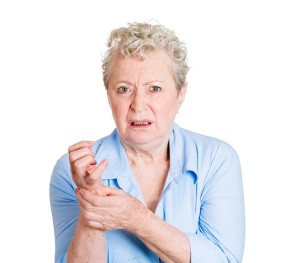Symptoms of osteoarthritis are usually insidious and take often several years to develop. Usually only one or very few joints are affected. The earliest sign is pain and swelling with exercise.
With rest the symptoms improve, overnight the affected joint stiffens up, but it remobilizes very quickly after morning stiffness of less than 30 minutes.
Decrease of joint motion
As time goes on the joint no longer has a full range of motion (ROM), it is getting stiffer. With the inflammation there is swelling of the synovial lining of the joint and breakdown of the cartilage surface leading to pitting of the joint surface. This gives the feeling of grinding when the joint moves and we can feel this as crepitation from outside.
Occasionally with a lot of inflammation there can be an accumulation of inflammatory exudate called “effusion”, which makes the joint appear “puffed up”.
With a lot of fluid the pressure buildup can be so painful that the joint locks in place due to excruciating pain. The physician may have to freeze the joint capsule and take some fluid out for pressure relief.
Stiffening of the spine with aging
In the spinal area the facet joints provide mobility to the lumbar spine (lower back) and cervical spine (neck) areas. Degenerative changes in the facet joints, which happens in all of us to a certain degree after the age of 50, can lead to lower back or neck pain and stiffening of the spine in more severe cases.
References
1. The Merck Manual, 7th edition, by M. H. Beers et al., Whitehouse Station, N.J., 1999. Chapter 52.
2. ABC of rheumatology, second edition, edited by Michael L. Snaith , M.D., BMJ Books, 1999.
3. EL Cain et al. Clin Sports Med 2001 Apr;20(2):321-342.
4. B. Sears: “Zone perfect meals in minutes”. Regan Books, Harper Collins, 1997.
5. Goldman: Cecil Textbook of Medicine, 21st ed.(©2000)W.B.Saunders
6. Ferri: Ferri’s Clinical Advisor: Instant Diagnosis and Treatment, 2004 ed., Copyright © 2004 Mosby, Inc.
7. Rakel: Conn’s Current Therapy 2004, 56th ed., Copyright © 2004 Elsevier








